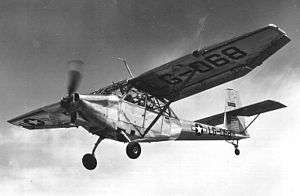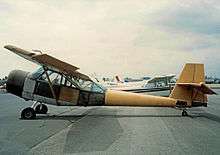Stinson L-13
The Stinson L-13 (sometimes known as the Grasshopper, like other aircraft of its type) was a US military utility aircraft first flown in 1945. Developed when Stinson was a subsidiary of Consolidated Vultee, rights to it were not included in the 1948 sale of Stinson to Piper. Mass production was therefore undertaken by Convair, which built some 300 of them.
| L-13 Grasshopper | |
|---|---|
 | |
| Note the windows in the roof giving excellent field of vision | |
| Role | Observation and Utility Aircraft |
| Manufacturer | Stinson Aircraft Company |
| First flight | 1945 |
| Introduction | 1947 |
| Primary users | United States Air Force United States Army |
| Number built | 302 |
It was a conventional high-wing tailwheel monoplane used for observation, liaison, and air ambulance duties. Following their military service, some were converted for civil bush flying use, fitting a radial engine by Acme Aircraft Company as the Centaur, while others underwent similar conversions by Caribbean Traders Inc, as the Husky.[1]
Variants
- XL-13
- Prototype aircraft, powered by 245 hp (183 kW) Franklin O-425-6 engine. Two built.[2]
- L-13A
- Production aircraft, powered by 250 hp (187 kW) O-425-9 engine. 300 built.[2]
- L-13B
- Conversion of L-13A for cold weather operation, capable of operating from wheels, skis or floats. 28 converted.[3][4]
- Acme Centaur 101
- Conversion of L-13 as six-seat bush aircraft. Powered by 300 hp (224 kW) Lycoming R-680-E3.[1]
- Acme Centaur 102
- Similar to Acme Centaur 101, with a 300hp Jacobs R-755-A2 radial.[1]

- Caribbean Traders Husky I
- Civil conversion of L-13A. Retained O-425 engine.[1][5]
- Caribbean Traders Husky II
- Civil conversion of L-13A. Powered by 300 hp R-680-13 engine on modified engine mount capable of swinging out for easy maintenance.[1][5]
- Caribbean Traders Husky III
- Similar to Husky II, but powered by 450 hp (338 kW) Wright R-975-7 radial engine.[1][5]
- Servicair Loadmaster
- Reconstruction of L-13A with 450 hp Pratt & Whitney R-985-AN-1 radial engine and rearranged four-seat cabin.[6]
Operators
- United States Air Force
- United States Army received 43 ex-Air Force L-13As following the outbreak of the Korean War, serving in the Continental United States to free up aircraft for active service overseas.[7]
Specifications (L-13A)
Data from General Dynamics Aircraft and their Predecessors [8]
General characteristics
- Crew: 1
- Capacity: 2 passengers
- Length: 31 ft 9 in (9.68 m)
- Wingspan: 40 ft 5 1⁄2 in (12.332 m)
- Height: 8 ft 5 in (2.57 m)
- Wing area: 270 sq ft (25 m2)
- Empty weight: 2,070 lb (939 kg)
- Gross weight: 3,185 lb (1,445 kg)
- Powerplant: 1 × Franklin O-425-9 air-cooled flat-six engine, 250 hp (190 kW)
Performance
- Maximum speed: 115 mph (185 km/h, 100 kn)
- Cruise speed: 92 mph (148 km/h, 80 kn)
- Range: 368 mi (592 km, 320 nmi)
- Service ceiling: 15,000 ft (4,600 m)
- Rate of climb: 830 ft/min (4.2 m/s)
See also
Aircraft of comparable role, configuration and era
- L-19 Bird Dog
Notes
- Wegg 1990, pp. 180-181.
- Wegg 1990, p.180.
- Harding 1990, p.92.
- Swanborough and Bowers 1963, p.489.
- Flight 9 September 1955, p.466.
- Taylor 1961, p. 316.
- Harding 1990, pp. 91-92.
- Wegg 1990, p.182.
References
| Wikimedia Commons has media related to Stinson L-13. |
- "Convair Conversion." Flight, 9 September 1955, p. 466.
- "Plane With Folding Wings Can Be Towed Like A Glider" , March 1947, Popular Mechanics rare photos of L-13 folded for towing by jeep
- Harding, Stephen. U.S. Army Aircraft Since 1947. Shrewsbury, UK:Airlife, 1990. ISBN 1-85310-102-8.
- Swanborough, F.G. and Bowers, Peter M. United States Military Aircraft since 1909. London:Putnam, 1963.
- Taylor, John W. R. Jane's All the World's Aircraft 1961–62. London: Sampson Low, Marston & Company, Ltd., 1961.
- Wegg, John. General Dynamics Aircraft and their Predecessors. London:Putnam, 1990. ISBN 0-85177-833-X.